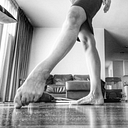Ballet dictionary for adults. How to do a battement fondu
Welcome to the Ballet Dictionary for Adults, episode #5. “Ballet Dictionary for adults” is a project where I give thorough explanation of basic ballet movements with tips and tricks specifically for adult ballerinas. I also give links to useful videos from the ballet teachers that I trust.
In this session I will talk about how to do a battement fondu.
In my explanations I go by the legendary book “Basic principals of classical ballet” by Vaganova. Lifehacks for adults are purely my own (I’ve been doing ballet for 11 years in total, I write about it in my blog) observations and experience. I only give the tips that actually did work for me.
What is a battement fondu?
Fondu means “melting” in French. This means that battement fondu should be performed very smoothly. Just like melting snow (or cheese, as in swiss fondu:), you need to go smoothly and slowly into plie — and then up from plie simultaneously with straightening your leg.
Battement fondu rules from Vaganova
- In this battement the knee is not raised and the leg is not lifted. These two things are done only when the exercise is performed with the legs at an angle of 45 or 90 degrees.
- Legs should be turned out as carefully as in battements tendus. For example, when performing the movement back you should not drop your knee and keep the upper part of your leg well turned out.
This movement belongs to the category of more complicated exercises, as the standing leg actively participates, doing a plie simultaneously with a battement done by the other leg.
Tips for adults
- Do not forget to turn out the standing leg properly. Battement fondu basically starts with a demi plie. Which means that here you also need to follow all the rules of demi plie. Adults tend to fully focus on the working leg, trying very hard to have a good turn out. And they easily forget about the standing leg.
A tip for proper turnout. Keep in mind that plie in battement fondu is more about turning out than going down. When you try really hard turning your hips out and making your knees look behind, the going down (knee bending) process happens naturally. So put your focus on turnout, not on artificially bending your knees.
2. Make sure your sur le cou-de-pied is correct. Battement fondu is based on sur le cou-de-pied position. If you translate this term literally, it will be something like “on the neck of your foot”. Funny, right?). Does a foot have a neck? What is meant here is that the point of your working foot (actually, the thumbnail of your working foot) should be exactly on top of your inner ankle bone. Just like on the picture below.
3. Strive upwards with your spine. Just like in any other ballet exercise, containing plie, the top of your head should “aspire to reach the sky”, while your heels stand firmly on the ground. So, when doing battement fondu, your body kind of tries to reach in two opposite directions: the lower part — to the ground, the upper part — to the ceiling.
4. Do not lift the hip of your working leg. Whatever direction your legs go, the hips should stay immovable.
When I started to film myself at ballet classes, I saw that I slightly lift my hip when my leg goes back to sur le cou-de-pied after moving backwards in battement fondu.
Try to control your hips as much as you can, so that your body gets used to the fact that your hips should stay as straight as they can.
In the short video below (with English subs) Ilya Kuznetsov — an adult ballet teacher in Dance Secret studio in Moscow, Russia — shares all the details of a correct battement fondu and mentions a few typical mistakes that adults make when performing it.
Previous episodes in Ballet Dictionary for Adults
Author — Evgenia Budrina. I am a dance enthusiast from Russia.
I started doing ballet at 31. In my blog I write about and for those who started dancing as adults and take it seriously. Personal stories, failures, life-hacks and thoughts.
My Instagram — @_a.dancer_
